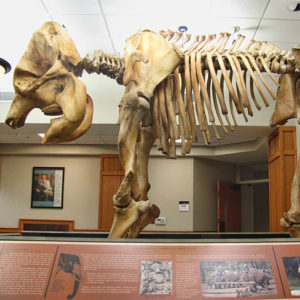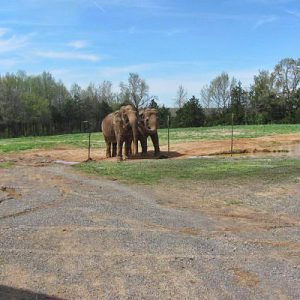calsfoundation@cals.org
Riddle's Elephant and Wildlife Sanctuary
Opened in 1990 by Scott and Heidi Riddle, Riddle’s Elephant and Wildlife Sanctuary was located on 330 acres outside of Greenbrier (Faulkner County). The sanctuary provided a permanent home for African and Asian elephants in need of sanctuary for any reason, regardless of age, sex, species, health, or temperament. Elephants came from private owners, circuses, or zoos. The 501(c)(3) nonprofit sanctuary—which raised money through grants and donations—housed up to a dozen elephants at any given time, with several baby elephants born at the facility. Maximus, an African elephant born at the sanctuary in 2003, starred in Animal Planet’s television show Growing Up Elephant.
Scott and Heidi Riddle met while both were working at the Los Angeles Zoo, and they married in 1986. Heidi Riddle served on the board of directors and as president of the Elephant Managers Association (EMA), to which Scott Riddle also belonged.
The sanctuary was involved in various aspects of elephant research. The staff took blood samples from the elephants each month to provide data for research on elephant diseases. The sanctuary worked to help develop an elephant repellant to be used in areas of the world facing conflicts between humans and elephants. Science students at Hendrix College in nearby Conway (Faulkner County) worked with the sanctuary over the years. Dr. Keith Sutton, a biology professor at Hendrix College, worked on several projects with the sanctuary. After Sutton’s death in 2001, the Riddles donated the skeleton of Kate, a former circus elephant that had to be euthanized after a hip injury, to the Donald W. Reynolds Center for Life Sciences at Hendrix to be displayed as a memorial to Sutton.
The sanctuary was not without controversy. In 2004, People for the Ethical Treatment of Animals (PETA) sent a letter to the deputy administrator of the U.S. Department of Agriculture asking the department to investigate the sanctuary based on allegations that Scott Riddle and the staff mishandled elephants, including beating a young elephant with a bullhook, allowing an elephant to be gored by another, poor foot care, insufficient drinking water, excessive chaining, and use of electrical prods. According to the Captive Animals Protection Society in Manchester, England, the Blackpool Zoo would not employ Riddle again to work with its four elephants after he used electrical prods and other “circus-style” training methods on elephants while he was in charge at an elephant training seminar. PETA and others also criticized Riddle’s Sanctuary for allowing public access to the elephants and for serving as a breeding operation rather than as a true sanctuary for animals in need.
Visitors were allowed see the elephants on the first Saturday of every month; requested donations were $5 per person. An “Adopt the Elephant” program offered people a chance to donate money to provide food and veterinary care for the elephants. The sanctuary hosted the Elephant Experience Weekend several times a year, which gave people a chance to get close to elephants and see what went into caring for them on a day-to-day basis. In 2009, Faulkner County residents were encouraged to deliver leftover Halloween pumpkins and hay bales to Simmons First National Bank locations to be given to the elephants as a seasonal treat. Beginning in 1994, the sanctuary held an annual course called the International School for Elephant Management, a comprehensive course covering elephant care and management, from nutrition to reproduction.
The sanctuary had closed by 2020.
For additional information:
Potter, Dena. “Elephants, Guests Find Sanctuary in Ozarks.” Chicago Tribune. December 25, 2009. Online at http://www.chicagotribune.com/travel/ct-travel-ozark-elephants-story,0,7260058.story (accessed August 14, 2023).
Ali Welky
CALS Encyclopedia of Arkansas
 Elephant Skeleton
Elephant Skeleton  Riddle's Elephant and Wildlife Sanctuary
Riddle's Elephant and Wildlife Sanctuary  Riddle's Elephant and Wildlife Sanctuary
Riddle's Elephant and Wildlife Sanctuary 




Comments
No comments on this entry yet.